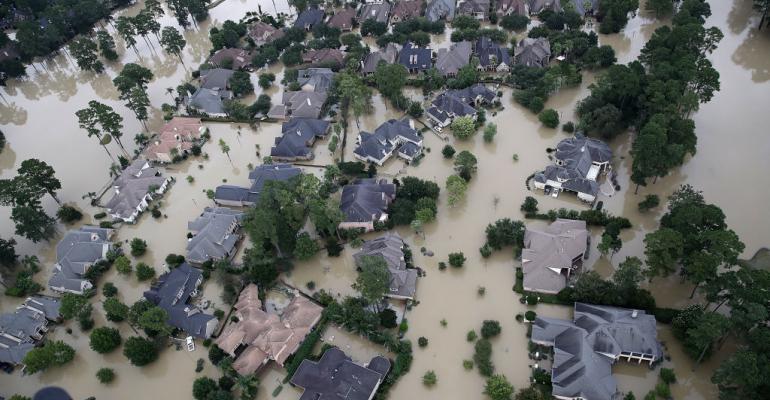Earlier this year Hurricane Dorian, an extremely powerful Category 5 tropical cyclone, churned through the Caribbean, devastating the Bahamas and the southeastern United States and leaving 70,000 people homeless. It was the strongest hurricane measured since 2005’s Hurricane Wilma, with sustained winds of 185 miles per hour. While rescue workers, first responders, and survivors are busy picking up the pieces from this most recent disaster, another tropical storm may soon be on its way.
It’s not your imagination: over the past few decades, natural disasters—fueled by climate change—have been hitting more often and with increasingly devastating effects, year after year. Munich Re, one of the world’s leading reinsurers has said that 2017-2018 was the worst two-year period for natural disasters on record, with insured losses totaling some $225 billion.
The data doesn’t lie. Even the U.S. government, which, to put it mildly, has occasionally expressed skepticism towards climate change, noted in January 2018 that 2017 was by far the costliest year ever in terms of impacts from “Billion-Dollar Disaster Event Costs.” In 2017, there were 16 natural disasters in the U.S. that caused at least $1 billion in damages, with overall impacts totaling an astonishing $306.2 billion. The damage from Hurricanes Harvey, Irma, and Maria alone accounted for $260 billion of the damage, and those three 2017 hurricanes joined Katrina and Sandy in the list of the top five costliest hurricanes ever recorded.
What does all of this have to do with real estate investing? Everything. Climate change has grown into what should be a dominant consideration and risk for real estate investors. Many REITs have failed to properly take its effects into account with traditional passive diversification. This is partially happenstance, given how most real estate companies and REITs are created as locally-grown developers or nationally-focused product specialists. Passive approaches to real estate investing typically slice up the market according to geographic regions or sectors (residential, office, etc.), without taking the nuanced, property-by-property approach that active portfolio management favors. Moreover, some of the highest growth, booming real estate markets on paper (for example New York City, New Orleans, or Miami) are disproportionately exposed to climate change. With approximately 35 percent of all global REIT-owned properties exposed to climate hazards, such an approach will almost invariably leave a REIT overly exposed to climate risk.
As climate change grows to play an increasingly dominant role in real estate investment decisions, active portfolio management, which involves judgment calls that can’t be easily codified into a passive, rules-based framework, is already proving to be a critical tool for selecting resilient, yet still profitable opportunities. By examining the on-the-ground realities on a property-by-property basis, active management can take into account such arcana as FEMA flood zones (and if they are out of date), topography, drainage, infrastructure, resilience of structures (roofs in particular), recent wildfire data, and more to inform intelligent investment portfolio allocation decisions.
An active, climate change-aware approach to real estate investing also means that managers can be more discerning and nuanced when it comes to areas that at first glance may appear to be overly exposed to climate change. For example, it’s common knowledge that Florida is threatened by rising sea levels and increasingly powerful storms, but Florida is also experiencing high rates of population growth with a corresponding surge in demand for housing—how to gain exposure to this important market, while also being mindful of the risks of climate change? In this case, it may make more sense to look inland to somewhere like Orlando, where a higher elevation makes it a bit less prone to disastrous flooding, especially when compared to coastal cities like Miami. From there, a would-be real estate investor should take a careful look at the aforementioned details (FEMA flood zones, topography, etc.) before making an investment decision. The work doesn’t stop there, however.
Once the property is purchased, a good, proactive real estate investor takes the next step by planning ahead for climate change-related hazards. By upgrading the infrastructure of a property to hurricane-resistant metal roofs, and possibly even installing solar panels and batteries to guard against future power outages, active managers can even achieve anti-fragility. This means their property possibly stands to benefit from climate change; when surrounding properties are damaged, but yours survives relatively unscathed, it can translate into higher occupancy and higher returns over time.
Driven by climate change, natural disasters, including hurricanes, wildfires, and flooding, only stand to get more destructive, more frequent, and more costly over time. It’s clear that only an active approach is sufficient to take into account the important on-the-ground details that may play a pivotal role in protecting properties from their effects. By looking beyond simple, rules-based frameworks, real estate managers may even stand a chance of thriving in this challenging environment.
The views and opinions expressed in this article are solely those of the author.
Jonathan Needell serves as president and chief investment officer of KIMC, a real estate investment company focused on making a positive environmental and social impact.





